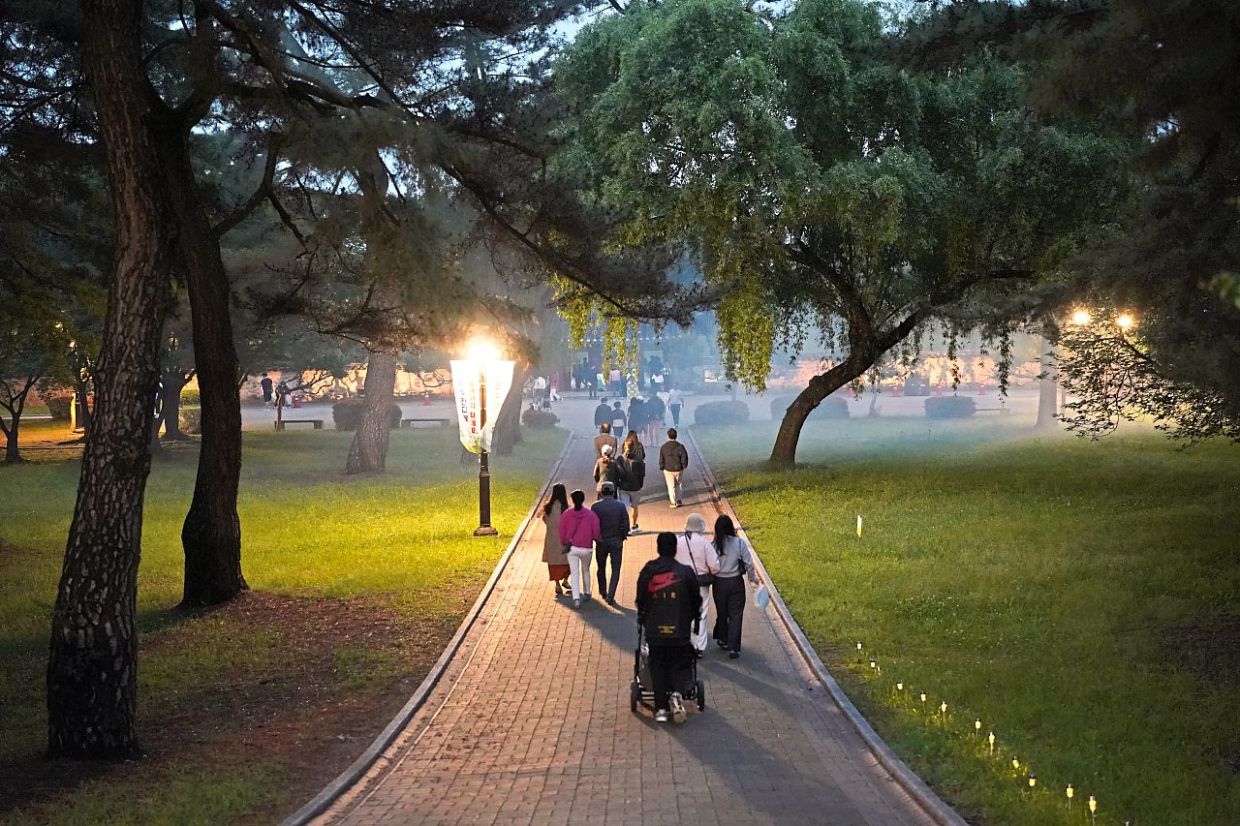
A tourist taking a photo of a projection of a gold crown on the Hwangnam Daechon Tomb at Daereungwon in Gyeongju. — The Korea Herald/ANN
SUMMER 1973. The sights and sounds of excavations descended on Gyeongju, in the southeastern part of South Korea, turning the entire city into a massive archaeological project. If a Korean movie studio ever decides to make its own version of Indiana Jones, they would not have to search much for an opening-scene inspiration.
The “comprehensive tourist development” of the ancient royal capital of Silla, a pet project of then president Park Chung-hee, triggered the cacophony. Famously called “the museum without walls,” Gyeongju needed to look into its ubiquitous underground remains before any construction work could begin.
Some of the elderly residents had misgivings. But their worry that disturbing royal tombs would enrage their occupants was submerged in the rush to embark on the first pre-planned archaeological excavation ever to be conducted by Koreans. Archaeological surveys and excavations had begun in Korea during the early half of the 20th century, but were mostly undertaken by the Japanese during their colonial occupation.
Hundreds of massive royal burial mounds scattered around central Gyeongju became the axis. There, the so-called Tomb No 155 became a testing ground for systematic procedures that were to be applied to much larger twin mounds nearby so its interior could be opened for tourists. But the plan was unwittingly destined for distinction; the test excavation itself would become monumental.
A prolonged dry spell ensured that the dust and din of the excavation was constant – and it was all cloaked in secrecy. An iron fence surrounded Tomb No 155, keeping a swarm of reporters and photographers at bay. Even morsels of information were scarce.
Finally, in July, three months after the first shovel dug into the mound, the clouds opened. Thunder claps ushered in an abrupt downpour. The news vigil outside the fence broke up. The next morning, the whole country awakened to news that a gold crown had been found. Despite the airtight security, a local correspondent from the Hankook Ilbo had managed to get the scoop.
How the crown was unearthed and wiped has the breathtaking ambience we associate with Indiana Jones scenes. A 1974 report by the Bureau of Cultural Property at the Ministry of Culture and Information, the predecessor of today’s Cultural Heritage Administration, retraces the archaeologists’ moments:
“As we were about to lift the shining gold crown, the clear sky suddenly turned dark and the rain started pouring down with thunder and lightning. Awed by the sudden change in the cosmic energy, we retrieved the crown with pious minds. By the time we finished some essential cleansing, the night sky had completely cleared up.”
Discovery of a gold crown and other jewellery of the Silla royalty was no doubt sensational news, but a bigger surprise followed a month later with a discovery that was not only unexpected but seemingly unfathomable. The tomb yielded a pair of saddle flaps, each made of layers of white birch bark and carrying a painted image of flying white horse.“It was a miracle to find the heavenly horse image underneath the upper plate of the wooden box containing funeral offerings,” noted Ji Gon-gil, a junior researcher of the excavation team, who later served as director general of the National Museum of Korea.
He went on, “It was a mystery how the fragile birch bark had survived all these years underground. The heavenly horse and the exquisite patterns surrounding it were as vivid as if the painter had just laid down his brush.”Later, Tomb No 155 was renamed the “Heavenly Horse Tomb.”
My visit to Gyeongju recently was my first in many years. Back in 1973, I was nearly the youngest among the journalists who flocked there from around the country for coverage of archaeological news. My trip was timed for a special exhibition at the Gyeongju National Museum, marking the 50th anniversary of the excavation of the Heavenly Horse Tomb as a landmark event in Korean archaeology. Then it led to a reunion with Woo Byung-ik, who made the sensational exclusive report on the discovery of a gold crown, at his home in the old city center.
We had a chest of memories to unpack – how we had long dinners, sometimes with archaeologists as well, at small restaurants, which, regrettably have since disappeared; how we enjoyed the nightlife in Gyeongju, the only South Korean city without a night curfew at the time; how we rushed to our newspaper’s bureau office to dictate our reports to a colleague in Seoul over the phone; how we asked intercity express bus drivers to deliver our film rolls to the Seoul terminal, where someone from our newspaper would be waiting.
Back then, we did not own a car. We had to depend on city buses, a bicycle and our tired legs to shuttle between excavation sites and other places. Of course, laptop computers, digital cameras and the internet have revolutionized news gathering but the competitive spirit persists.
“We journalists waged a war of our own covering the excavations, didn’t we?” said Woo, recalling his scoop. “It was an exciting time for us journalists as well as archaeologists, wasn’t it?”
A native son of Gyeongju, Woo is now a nonagenarian well known in the local community as a retired journalist and patron of Silla culture.
The anniversary exhibit at the Gyeongju National Museum was relatively simple. It included select artefacts of gold jewelry, understandably intended to focus on the single centrepiece: the flying heavenly horse.
Considering the extreme vulnerability of the material, the two mudguards were exhibited in rotation during the roughly two-month-long exhibition. Facing the ancient king’s equestrian gear, partially crackled and discoloured, cautiously displayed in a glass box in a dimly lighted hall where photography was banned, with museum staff standing guard, I was awestruck.
It was an encounter across 15 centuries. Flying up from underneath the colossal piles of gravel and earth protecting the royal mausoleum, what message was the mysterious animal conveying to us? — The Korea Herald/ANN
Lee Kyong-hee is a former editor-in-chief of The Korea Herald.











































